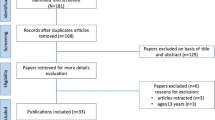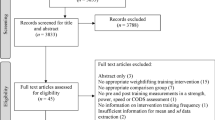Abstract
Background
Increases in muscular strength may increase sports performance, reduce injury risk, are associated with a plethora of health markers, as well as exerting positive psychological effects. Due to their efficiency and effectiveness in increasing total body muscular strength, multi-joint exercises like the powerlifts, i.e.: the squat (SQ), bench-press (BP) and deadlift (DL), are widely used by active individuals as well as athletes in the pursuit of increasing strength. To date, the concept of a minimum dose, i.e. “what is the minimum one needs to do to increase 1-repetition maximum (1RM) strength?” has not been directly examined in the literature, especially in the context of the powerlifts. This review aims to explore the current available evidence around the minimum effective training dose required to increase 1RM strength in trained individuals in an attempt to enhance the practical guidelines around resistance-training as well as provide active individuals, athletes and coaches with more flexibility when designing a training protocol.
Methods
One reviewer independently conducted the search in a PRISMA systematic approach using PubMed, SportDiscus and Google Scholar databases. The databases were searched with the following search terms/phrases and Boolean operators: “training volume” AND “powerlifting” OR “1RM strength” OR “powerlifters”, “low volume” AND “powerlifting” OR “powerlifting” OR “1RM strength”, “high vs low volume” AND “powerlifting” OR “1RM strength”, “minimum effective training dose 1RM”. Meta-analyses were performed to estimate the change in 1RM strength for the lowest dose group in the included studies.
Results
From the initial 2629 studies, 6 studies met our inclusion criteria. All identified studies showed that a single set performed minimum 1 time and maximum 3 times per week was sufficient to induce significant 1RM strength gains. Meta-analysis of 5 studies showed an estimated increase for overall 1RM of 12.09 kg [95% CIs 8.16 kg–16.03 kg], an increase of 17.48 kg [95% CIs 8.51 kg–26.46 kg] for the SQ, and 8.25 kg [95% CIs 0.68 kg–15.83 kg] for the BP. All of the included studies contained details on most of the variables comprising “training dose”, such as: weekly and per session sets and repetitions as well as intensity of effort. Specific information regarding load (%1RM) was not provided by all studies.
Conclusions
The results of the present systematic review suggest that performing a single set of 6–12 repetitions with loads ranging from approximately 70–85% 1RM 2–3 times per week with high intensity of effort (reaching volitional or momentary failure) for 8–12 weeks can produce suboptimal, yet significant increases in SQ and BP 1RM strength in resistance-trained men. However, because of the lack of research, it is less clear as to whether these improvements may also be achievable in DL 1RM strength or in trained women and highly trained strength athletes.
Registration
This systematic review was registered with PROSPERO (CRD42018108911).



Similar content being viewed by others
References
Artero E, Lee D, Ruiz J, Sui X, Ortega F, Church T, Lavie C, Castillo M, Blair S. A prospective study of muscular strength and all-cause mortality in men with hypertension. J Am Coll Cardiol. 2011;57:1831–7.
Suchomel T, Nimphius S, Stone M. The Importance of muscular strength in athletic performance. Sports Med. 2016;46:1419–49.
Steele J, Fisher J, Skivington M, Dunn C, Arnold J, Tew G, Batterham A, Nunan D, O’Driscoll J, Mann S, Beedie C, Jobson S, Smith D, Vigotsky A, Phillips S, Estabrooks P, Winett R. A higher effort-based paradigm in physical activity and exercise for public health: making the case for a greater emphasis on resistance training. BMC Public Health. 2017;17:300.
Mangine G, Hoffman J, Gonzalez A, Townsend J, Wells A, Jajtner A, Beyer K, Boone C, Miramonti A, Wang R, LaMonica M, Fukuda D, Ratamess N, Stout J. The effect of training volume and intensity on improvements in muscular strength and size in resistance-trained men. Physiol Rep. 2015;3:e12472.
Schoenfeld B, Peterson M, Ogborn D, Contreras B, Sonmez G. Effects of low- vs. high-load resistance training on muscle strength and hypertrophy in well-trained men. J Strength Cond Res. 2015;29:2954–63.
Barbalho M, Coswig V, Steele J, Fisher J, Paoli A, Gentil P. Evidence for an upper threshold for resistance training volume in trained women. Med Sci Sports Exerc. 2019;51:515–22.
Schoenfeld B, Ogborn D, Krieger J. Dose-response relationship between weekly resistance training volume and increases in muscle mass: a systematic review and meta-analysis. J Sport Sci. 2016;35:1073–83.
Steele J. Intensity; in-ten-si-ty; noun. 1. Often used ambiguously within resistance training. 2. Is it time to drop the term altogether? Br J Sports Med. 2013;48:1586–8.
Zourdos MC, Klemp A, Dolan C, Quiles JM, Schau KA, Jo E, Helms E, Esgro B, Duncan S, Garcia Merino S, Blanco R. Novel resistance training-specific rating of perceived exertion scale measuring repetitions in reserve. J Strength Cond Res. 2016;30:267–75.
Androulakis-Korakakis P, Fisher J, Kolokotronis P, Gentil P, Steele J. Reduced volume ‘daily max’ training compared to higher volume periodized training in powerlifters preparing for competition—a pilot study. Sports. 2018;6:86.
Coutts A, Reaburn P, Piva T, Murphy A. Changes in selected biochemical, muscular strength, power, and endurance measures during deliberate overreaching and tapering in rugby league players. Int J Sports Med. 2007;28:116–24.
Pritchard H, Tod D, Barnes M, Keogh J, McGuigan M. Tapering practices of new zealandʼs elite raw powerlifters. J Strength Cond Res. 2016;30:1796–804.
Raeder C, Wiewelhove T, Westphal-Martinez M, Fernandez-Fernandez J, de Paula Simola R, Kellmann M, Meyer T, Pfeiffer M, Ferrauti A. Neuromuscular fatigue and physiological responses after five dynamic squat exercise protocols. J Strength Cond Res. 2016;30:953–65.
Ferreira D, Gentil P, Ferreira-Junior J, Soares S, Brown L, Bottaro M. Dissociated time course between peak torque and total work recovery following bench press training in resistance trained men. Physiol Behav. 2017;179:143–7.
Baechle T. Essentials of strength training and conditioning. 4th ed. Champaign: Human Kinetics; 2016.
Paoli A, Gentil P, Moro T, Marcolin G, Bianco A. Resistance training with single vs. multi-joint exercises at equal total load volume: effects on body composition, cardiorespiratory fitness, and muscle strength. Front Physiol. 2017;8:1105.
Fleck S, Kraemer W. Designing resistance training programs. 4th ed. Champaign: Human Kinetics; 2014.
Moher D. Preferred reporting items for systematic reviews and meta-analyses: the PRISMA Statement. Ann Intern Med. 2009;151:264.
Maher C, Sherrington C, Herbert R, Moseley A, Elkins M. Reliability of the PEDro scale for rating quality of randomized controlled Trials. Phys Ther. 2003;83:713–21.
Higgins JPT, Green S, editors. Cochrane handbook for systematic reviews of interventions. London: The Cochrane Collaboration; 2011.
Marshall P, McEwen M, Robbins D. Strength and neuromuscular adaptation following one, four, and eight sets of high intensity resistance exercise in trained males. Eur J Appl Physiol. 2011;11:3007–16.
Robbins D, Marshall P, McEwen M. The effect of training volume on lower-body strength. J Strength Cond Res. 2012;26:34–9.
Ostrowski K, Wilson G, Weatherby R, Murphy P, Lyttle A. The effect of weight training volume on hormonal output and muscular size and function. J Strength Cond Res. 1997;11:148–54.
Schoenfeld B, Contreras B, Krieger J, Grgic J, Delcastillo K, Belliard R, Alto A. Resistance training volume enhances muscle hypertrophy. Med Sci Sports Exerc. 2019;51:94–103.
Kramer J, Stone M, O’Bryant H, Conley M, Johnson R, Nieman D, Honeycutt D, Hoke T. Effects of single vs. multiple sets of weight training: impact of volume, intensity, and variation. J Strength Cond Res. 1997;11:143.
Rhea M, Alvar B, Ball S, Burkett L. Three sets of weight training superior to 1 set with equal intensity for eliciting strength. J Strength Cond Res. 2002;16:525–9.
Baker J, Davies B, Cooper S, Wong D, Buchan D, Kilgore L. Strength and body composition changes in recreationally strength-trained individuals: comparison of one versus three sets resistance-training programmes. Biomed Res Int. 2013;2013:1–6.
Lander J. Maximum based on reps. Strength Cond J. 1984;6:60.
Fisher J, Bruce-Low S, Smith D. A randomized trial to consider the effect of Romanian deadlift exercise on the development of lumbar extension strength. Phys Ther Sport. 2013;14:139–45.
Peterson M, Rhea M, Alvar B. Maximizing strength development in athletes: a meta-analysis to determine the dose-response relationship. J Strength Cond Res. 2004;20018:377.
Scott B, Duthie G, Thornton H, Dascombe B. Training monitoring for resistance exercise: theory and applications. Sports Med. 2016;46:697–8.
Carpinelli R, Otto R. Strength training: single versus multiple sets. Sports Med. 1998;27:409–16.
Fisher J, Steele J, Bruce-Low S, Smith D. Evidence-based resistance training recommendations. Med Sportiva. 2011;15:147–62.
Krieger J. Single versus multiple sets of resistance exercise: a meta-regression. J Strength Cond Res. 2009;23:1890–901.
Ralston GW, Kigore L, Wyatt FB, Baker JS. The effect of weekly set volume on strength gain: a meta-analysis. Sports Med. 2017;12:2585–601.
Gonzalez-Badillo J, Izquierdo M, Gorostiaga E. Moderate volume of high relative training intensity produces greater strength gains compared with low and high volumes in competitive weightlifters. J Strength Cond Res. 2006;20:73–81.
Fisher J, Steele J, Smith D. High- and low-load resistance training: interpretation and practical application of current research findings. Sports Med. 2017;47:393–400.
Schoenfeld B, Grgic J, Ogborn D, Krieger J. Strength and hypertrophy adaptations between low- vs. high-load resistance training. J Strength Cond Res. 2017;31:3508–23.
Benedict T. Manipulating resistance training program variables to optimize maximum strength in men: a review. J Strength Cond Res. 1999;13:289.
Mattocks K, Buckner S, Jessee M, Dankel S, Mouser J, Loenneke J. Practicing the test produces strength equivalent to higher volume training. Med Sci Sports Exerc. 2017;49:1945–54.
Brigatto F, Branz T, Zanini T, Germano M, Aoki M, Schoenfeld B, Marchetti P, Lopes C. Effect of resistance training frequency on neuromuscular performance and muscle morphology after eight weeks in trained men. J Strength Cond Res. 2019;8:2104–16.
Gomes G, Franco C, Nunes P, Orsatti F. High-frequency resistance training is not more effective than low-frequency resistance training in increasing muscle mass and strength in well-trained men. J Strength Cond Res. 2019;33:130–9.
Grgic J, Schoenfeld B, Davies T, Lazinica B, Krieger J, Pedisiz Z. Effect of resistance training frequency on gains in muscular strength: a systematic review and meta-analysis. Sports Med. 2018;48:1207–20.
Ralston GW, Kilgore L, Wyatt FB, Buchan D, Baker JS. Weekly training frequency effects on strength gain: a meta-analysis. Sports Med Open. 2018;1:36.
Prestes J, Lima C, Frollini A, Donatto F, Conte M. Comparison of linear and reverse linear periodization effects on maximal strength and body composition. J Strength Cond Res. 2009;23:266–74.
Harries S, Lubans D, Callister R. Systematic review and meta-analysis of linear and undulating periodized resistance training programs on muscular strength. J Strength Cond Res. 2015;29:1113–25.
Ronnestad B, Egeland W, Kvamme N, Refsnes P, Kadi F, Raastad T. Dissimilar effects of one- and three-set strength training on strength and muscle mass gains in upper and lower body in untrained subjects. J Strength Cond Res. 2007;21:157–63.
Richens B, Cleather D. The relationship between the number of repetitions performed at given intensities is different in endurance and strength trained athletes. Biol Sport. 2014;31:157–61.
Hoeger W, Hopkins D, Barette S, Hale D. Relationship between repetitions and selected percentages of one repetition maximum: a comparison between untrained and trained males and females. J Strength Cond Res. 1990;4:47.
Author information
Authors and Affiliations
Corresponding author
Ethics declarations
Funding
No sources of funding were used to assist in the preparation of this article.
Conflict of interest
Patroklos Androulakis-Korakakis, James P. Fisher and James Steele declare that they have no conflicts of interest relevant to the content of this review.
Rights and permissions
About this article
Cite this article
Androulakis-Korakakis, P., Fisher, J.P. & Steele, J. The Minimum Effective Training Dose Required to Increase 1RM Strength in Resistance-Trained Men: A Systematic Review and Meta-Analysis. Sports Med 50, 751–765 (2020). https://doi.org/10.1007/s40279-019-01236-0
Published:
Issue Date:
DOI: https://doi.org/10.1007/s40279-019-01236-0




